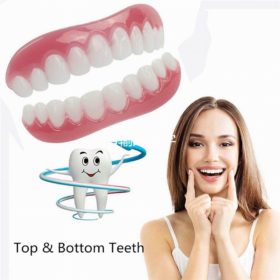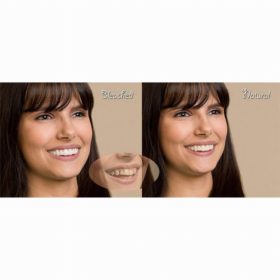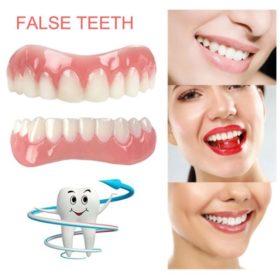Style
1. First best Complete Guide of Veneers vs. Dentures Treatments and Its Process
Do you have any dental issues? We will introduce you to dental veneers and dentures.
Many professional cosmetic procedures correct most of the existing dental disorders. According to evidence, more than 50% of the United States population visit dental experts for various corrective dental procedures every year. Here, we will discuss crooked teeth, misaligned jaw, tooth discoloration, chipped teeth, and gapped teeth, among others. These are some of the standard dental procedures that correct minor and severe dental problems.
This article contains essential details concerning veneers and dentures, veneers cost, and denture’s cost breakdown.
Veneers vs. Dentures
There are significant differences between Veneers and Dentures. The veneers attach to the front of existing teeth while veneers replace missing teeth is the primary difference between veneers and dentures. Also, veneers are permanent once applied while; dentures are removable.
Are you know about veneers?
There are thin coverings placed at the front of teeth, consisting of porcelain or composite resin called veneers. They are essential for those who have severely discolored teeth that are impossible to correct through bleaching.
Veneers are perfect for candidates with discolored teeth, chipped teeth, gaps, and damaged teeth from trauma. People having advanced gum disease, untreated cavities, or crooked teeth should not get veneers.
How Do Veneers Work?
Veneers are applied by removing 0.3 – 0.5 millimeters off the tooth’s surface to save the nerve of the tooth, ensuring that your veneers teeth last for a long time and keep it at maximum strength.
Your dentist can make the best recommendation as to how many individual veneers you need.
Moreover, you can get full veneers that cover entirely the tooth or partial veneers that only cover damaged or discolored areas. Many people choose only to veneer their front teeth since those are the most visible.
Sometimes your dentist can fit in individual tooth veneers like puzzle pieces if much of your smile is already the way you want it; each veneer can be colored to match your existing teeth for a seamless look.
What Do Veneers Look Like?
Veneers are appropriately crafted, customized, and applied dental veneers look just like better or enhanced versions of your natural teeth. If you have a gray or discolored tooth from previous damage or injury, dental veneers can also help fix that. Tooth veneers can also help smooth over teeth with bulges, craters, or have uneven surfaces or edges. Veneers are an excellent option for someone who doesn’t have extensive damage to their teeth but wants to perfect their natural smile in a relatively non-invasive way.
How Long Do Veneers Last?
Properly installed porcelain veneers last for up to a decade if you take good care of them. If porcelain is similar to the texture and strength of your actual teeth, then the gum tissue tends to tolerate quite well. Veneers are pretty substantial as your actual teeth if you take care of them properly and keep certain precautions in mind.
If your dental veneers crack or get damaged, get them repaired or replaced, or contact your dentist immediately to assess the damage. Broken veneers can harm the tooth enamel or even the tooth’s root underneath, so it is essential to get any issues resolved right away.
Care For Veneers
The AACD suggests brushing and flossing just as you would your regular teeth. Consider limiting coffee stain-inducing foods. Keep in mind that veneers will need to be replaced at some point, no matter how well you take care of them.
Types Of Veneers
1. Composite Veneers
Composite veneers contain composite resin. They include two categories; direct and indirect veneers. Dentists manufacture natural composite veneers on the premises and apply them directly to your teeth.
Besides this, indirect composite veneers are custom-made. Therefore, you will have an appointment for the process.
Benefits of Composite Veneers
- Cost-effective and easy to repair.
- They can correct several cosmetic problems.
- Require a single appointment visit.
- They have a straightforward application process.
- They look natural as dentists apply many composite veneers in a single visit.
- Gum damage chances are low.
- It lasts between 4 and 6 years.
Disadvantages
- The resin material is weak and chips over time.
- Composite veneers stain within a short period.
- Patients need replacement frequently.
2. Porcelain Veneers
They consist of porcelain material. They are gold-standard veneers. The process of application of the porcelain veneers is similar to composite veneers. The difference is that they are custom-made. They also require two appointments for the successful completion of the application process.
Benefits of Porcelain Veneers
- They are long-lasting compared to other categories.
- They last for 15 years with proper maintenance.
- They are thin and look natural.
- Porcelain’s material is vital.
- They hardly stain.
- Porcelain veneers are not harmful to your gums.
Disadvantages
- Porcelain veneers are expensive.
- Special polishing is required.
- The application process has an invasive procedure.
- Tooth decay may develop under the veneers.
What Are Dentures?
A denture is a removable replacement used to fix missing teeth and their surroundings. Dentures can improve tooth decay, severe cavities, facial injury, and periodontal disease because this process looks like natural teeth.
Types of Dentures
There are two main types of dentures given below;
1. Complete Dentures
The complete dentures process is used when one is missing one or all teeth. They compose of a plastic base that matches the color of your gums. Complete dentures come in two categories; conventional or immediate.
Dentists place immediate dentures right after the removal of natural teeth. The individual does not need to wait for the healing time to have false teeth. The process of conventional dentures takes place 8-12 weeks after removing teeth and is better than immediate dentures.
2. Partial Dentures
Partial dentures are convenient and cost-effective for people who have lost their many natural teeth and are of two types cast and acrylic dentures. Similar to complete dentures, they are easily removable and consist of false teeth with a plastic base. They incorporate ultra-thin cobalt-chromium alloy, which aids in the stability and enhanced strength of teeth.
3. Implant-Supported Dentures
The prosthetic replacements are excellent permanent fixtures for an individual. A dentist attaches false teeth in the spaces of missing teeth with the help of implants consisting of titanium screws and custom crowns.
Implant-supported dentures are among the most reliable prosthetics for missing teeth due to their excellent stability; the titanium screws anchor the implants containing false teeth directly to the jawbone.
Dentures Application Procedure
- The dental expert examines the patient’s jaw to make an impression of the teeth and jaw shape.
- In the next step, a complete x-ray examination ensures no underlying issues and makes a mold of the upper and lower gums.
- During the second visit, the dentist will review the alignment between the lower and upper jaw and ensures that the patient gets dentures with a correct fit.
- Dental experts recommend losing fitting dentures with a wax base before the placement of the final custom-made dentures.
- At the final visit, the dentist will place the last custom-made teeth attached to a base that mimics the color of the gums.
Benefits of Dentures
- They are easily removable.
- They last long with proper care.
- Dentures appear like natural teeth.
- Every patient gets unique prosthetics.
- The prosthetics improve your smile.
- They prevent facial sagging.
- Dentures improve your confidence.
- The dental-support feature enhances speech and eating habits.
Perfect Instant Smile Veneers Cosmetic Teeth Veneer Dentures for Woman and Man Comfortable Instructions for beginners
1.Put the gutta-percha in warm water to soften, then stick it on
the denture then on the human teeth.
- The role of white teether is to melt into a gel after being released in water, which is used to stick dentures.
Description:
- Material: Silicone
- Specifications: upper teeth, lower teeth
- Size: about 60 mm
- Skin Type: general
- Applicable people: general
- Function: modifying teeth
Features:
- Natural and bright coloring without staining.
- Durable, super comfortable to use.
- For people with bad teeth. It can cover off the lost teeth can be installed on the crown to make your smile beautiful.
- Easy to use and remove, without damaging the tooth enamel and gums.
- For cosmetic purposes only.
Up to you!



